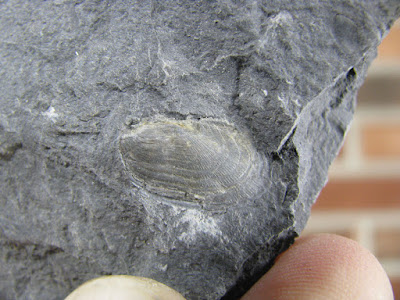The specimen - An isolated right valve. Anterior is to the left, Posterior to the right, The beak is about 1/4 of the way along the hinge line from the Anterior margin. (Don't forget to click on the pictures to get a larger view)
The "broken" striae is the part that threw me off because the shell bears a resemblance to Phthonia sectifrons and Pholadella radiata, both of which have strong concentric growth lines and radiating striae, but they just didn't match close enough. I wrote to Professor Karl Wilson of the SUNY at Binghamton and he suggested Grammatodon hamiltoniae.
A Google search for the name Grammatodon led me to a document I was familiar with that updated the names used in the well known (in the Devonian paleontology circles at least) book "Geology and Paleontology of 18 Mile Creek" by Amadeus Grabau. In the document it listed Gramatodon hamiltoniae as replacing Macrodon hamiltoniae. With that information I was able to look up the original description in the "Paleontology of New York" Vol 5, Part II, pg. 349 by James Hall:
MACRODON, LYCETT. 1845.
MACRODON HAMILTONIAE.
PLATE LI, FIGS. 1-7,9, 10.
Shell of medium size or larger, sub-elliptical or sub-ovate, wider behind; length about twice the height; basal margin broadly curving, sometimes nearly straight in the anterior portion. Posterior extremity broadly rounded, sometimes sub-truncate in the upper half. Cardinal line essentially straight, obtusely sub-angular at both extremities. Anterior end abruptly rounded or sub-truncate.
MACRODON HAMILTONIAE.
PLATE LI, FIGS. 1-7,9, 10.
Shell of medium size or larger, sub-elliptical or sub-ovate, wider behind; length about twice the height; basal margin broadly curving, sometimes nearly straight in the anterior portion. Posterior extremity broadly rounded, sometimes sub-truncate in the upper half. Cardinal line essentially straight, obtusely sub-angular at both extremities. Anterior end abruptly rounded or sub-truncate.
Valves convex in the posterior portion and gibbous in the anterior and umbonal portions.
Beaks sub-anterior, prominent, rising above the hinge-line. Umbonal region regularly gibbous.
Surface marked by regular, sub-equidistant, lamellose, concentric lines and by fine radiating strire, which are usually interrupted at the edges of the lamellae and become thickened at their lower extension. The radii are stronger on the posterior part of the shell.
The hinge structure has the usual characteristics of the genus.
Beaks sub-anterior, prominent, rising above the hinge-line. Umbonal region regularly gibbous.
Surface marked by regular, sub-equidistant, lamellose, concentric lines and by fine radiating strire, which are usually interrupted at the edges of the lamellae and become thickened at their lower extension. The radii are stronger on the posterior part of the shell.
The hinge structure has the usual characteristics of the genus.
The description matches much more closely to the shell I found. I am not sure when Macrodon was replaced with Grammatodon, but the latter was named by Meek and Hayden in 1860.
I do so love when a mystery gets solved.
This specimen was found at a borrow pit on Deep Springs Road in Madison County, NY which exposes the Windom shale member of the Moscow formation (middle Devonian in age, Givetian stage.)


No comments:
Post a Comment